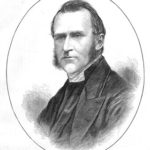Who was James (or Jacobus) Arminius? His actual name was Jacob Harmenszoon when he was born in Oudewater, Holland in 1559. His father died before his birth and thus Jacob was raised by a widowed mother. He received a Protestant education and actually lived with his teacher, Theodore Aemillius before his death in 1575. Arminius then studied at the University of Marburg for about a year. During this time his entire family was killed by Spanish invaders in August of 1575.
Arminius left Marburg and enrolled at the university in Leiden on October 23, 1576. It was here that he first used the name Jacobus Arminius, a latinized version of his name to follow the custom of the times for those seeking scholarly education. Jacobus is translated as James in English and thus most English scholars refer to him as James Arminius (sometimes as Jacob). At Leiden Jacobus became a top student in mathematics, logic, theology, and the Biblical languages of Hebrew and Greek. While at Leiden, Arminius tasted his first controversy within the Reformed churches when a local pastor, Caspar Coolhaes, held that John Calvin was wrong to assert that civil authorities did have certain powers in church affairs. It is believed also that Coolhaes held many of the views that Arminius would later teach and therefore had great influence on Arminius.
Following his graduation from the university in Leiden, Arminius was offered the opportunity to study at John Calvin’s academy in Geneva, Switzerland. The chair of theology at Calvin’s academy was held by Calvin’s successor, Theodore Beza. Beza was a hyper-Calvinist holding not only to the five points of Calvinism later to come but to double predestination as well. Arminius became known as Beza’s best known student. While in Geneva, Arminius was involved in controversy but not over predestination but logic. Scholars believe Arminius probably held to “high Calvinism” at the time. Because of the controversy, Arminius left Geneva but returned in 1586.
By mid 1586, the burgomasters in Amsterdam had decided that Arminius should pastor a church. Arminius left Geneva and visited Rome. It is reported by many that he kissed the pope’s slipper and consorted with various Roman Catholic Cardinals but there is no truth to this and Arminius never had a good word to say of popes. Arminius never held any of the tenants of the Roman Catholic Church.
In late 1587, Arminius arrived at Amsterdam and was ordained on August 27, 1588. As the pastor he would serve both church and city since there were no separation of the two at the time in history. The city of Amsterdam loved Arminius both as a civil leader and pastor. His preaching drew large crowds and he had no controversy until he was preaching through Romans and came to chapter 7 in 1591. Arminius preached that the person in verses 17-24 of Romans 7 was not a regenerate man but a sinner. Calvinist opposed this view and at the meeting of the ministers in January 1592, a fellow minister named Petrus Plancius declared Arminius’ views to be Pelagianism. Nonetheless the burgomasters supported Arminius and held that he was not out of line doctrinally from the Belgic Confession or the Heidelberg Catechism. The sermon on Romans 7 has not survived so we don’t know exactly what Arminius was teaching from the text.
His next controversy came in 1592. Arminius was still in Romans and he came to Romans 9. Once again Plancius brought charges that Arminius was teaching first that no one is condemned except by his own sin – which went against Beza’s doctrine of predestination and exclude infants from condemnation; secondly that he made too much of the role of good works; that he had taught that angels were not immortal. Arminius gave his reply and once again the ministers consistory found no fault with Arminius or his views.
From 1593 until 1603, Arminius enjoyed peace as he pastored and raised his family. The bubonic plague invaded Amsterdam in 1601 and claimed 20,000 victims. Arminius and his church reached out to the families as much as they could. During this time Arminius also wrote a great deal on theological issues from sin, grace, predestination, and the freedom of the will.
Beginning in 1603, Arminius faced continue controversy until his death on October 19, 1609. His opponent was Francisucs Gomarus, a fellow professor of theology at the university at Leiden where Arminius was now a teacher. From 1603 to 1609, Gomarus and Arminius was called to explain and defend their views before church officials. After Arminius’ death in 1609, his followers (and students) presented a petition to the States (church leaders of Holland). The petition was called a “Remonstrance” and Arminius’ followers became the “Remonstrants.” Among the students of Arminius were Uitenbogaert, Simon Episcopius, and a lawyer named Hugo Grotius.
The debate raged until on January 14, 1619 the Remonstrant defenders were dismissed, their views condemned as heresy and the Synod of Dort adopted the five “canons” in opposition to the Remonstrance. These five canons became the five points of Calvinism. The opposition to the Remonstrants, now officially condemned as heretics, and therefore under the condemnation of the church and state, was severe. All Arminian pastors – some 200 of them – were deprived of office and were to condemned to silence. Any who continued to preach were banned from the country. Beheadings, burnings, and imprisonment followed. It was not until 1625 that the Remonstrants were given religious tolerance by the state but not the church. The church continued to persecute Remonstrants until 1630 when the state ruled that the Remonstrants could practice their faith in peace, to build churches and schools. Arminians (as they became to be known) established a theological seminary in Amsterdam that remains to this day but sadly has become liberal along with Amsterdam.
In part three of this series on what is Reformed Arminianism, we will begin to study the doctrines that both unite and divide Calvinist. Looking back 500 years later, it is hard to believe that Calvinist could be so harsh toward Arminians considering that there is actually much that unites James Arminius and John Calvin and little that divides them. However, it is what divides them that cost many lives following the Synod of Dort.
[Link to original post on Roy Ingle’s blog]





